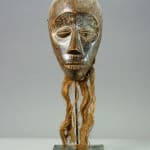Lega Wooden Mask with Raffia Fiber Beard, 20th Century CE
Wood, Raffia
6.375 x 19.75
PF.4686
Further images
Masks play an astonishing number of roles in most African societies. They are critical elements in functions as diverse as funerary rituals, ancestor cults, secret societies, divination, law enforcement, and...
Masks play an astonishing number of roles in most African societies. They are critical elements in functions as diverse as funerary rituals, ancestor cults, secret societies, divination, law enforcement, and healing. Essentially, the mask acts as an intermediary between the physical world of human beings and the non-physical realm of the spirit; including ancestors, animals, bush spirits, and innumerable divinities. For the Lega, masks are a crucial part of initiation ceremonies involving dramatic performances of dance, song, and recitations of proverbs.
The beauty of this mask lies in its dramatic quality and simplicity of design. It exudes an otherworldly aspect in its powerful gaze, which seems to penetrate through the material existence into other dimensions. The rich and lovely patina adds gloss and luster, which nicely contrasts with the coarseness of the raffia fibers. The mask was probably owned by a member of the bwami association, and used to signify rank. It therefore would have been regarded as an emblem of pride, signifying the owner had achieved a level of wisdom and moral integrity recognized by his peers. For such an important purpose, a talented sculptor was needed to create a mask that displayed human emotions, inspired respect and evoked a certain mystery while still being aesthetically pleasing. To see this mask is to know the sculptor has succeeded in his task.
The beauty of this mask lies in its dramatic quality and simplicity of design. It exudes an otherworldly aspect in its powerful gaze, which seems to penetrate through the material existence into other dimensions. The rich and lovely patina adds gloss and luster, which nicely contrasts with the coarseness of the raffia fibers. The mask was probably owned by a member of the bwami association, and used to signify rank. It therefore would have been regarded as an emblem of pride, signifying the owner had achieved a level of wisdom and moral integrity recognized by his peers. For such an important purpose, a talented sculptor was needed to create a mask that displayed human emotions, inspired respect and evoked a certain mystery while still being aesthetically pleasing. To see this mask is to know the sculptor has succeeded in his task.





